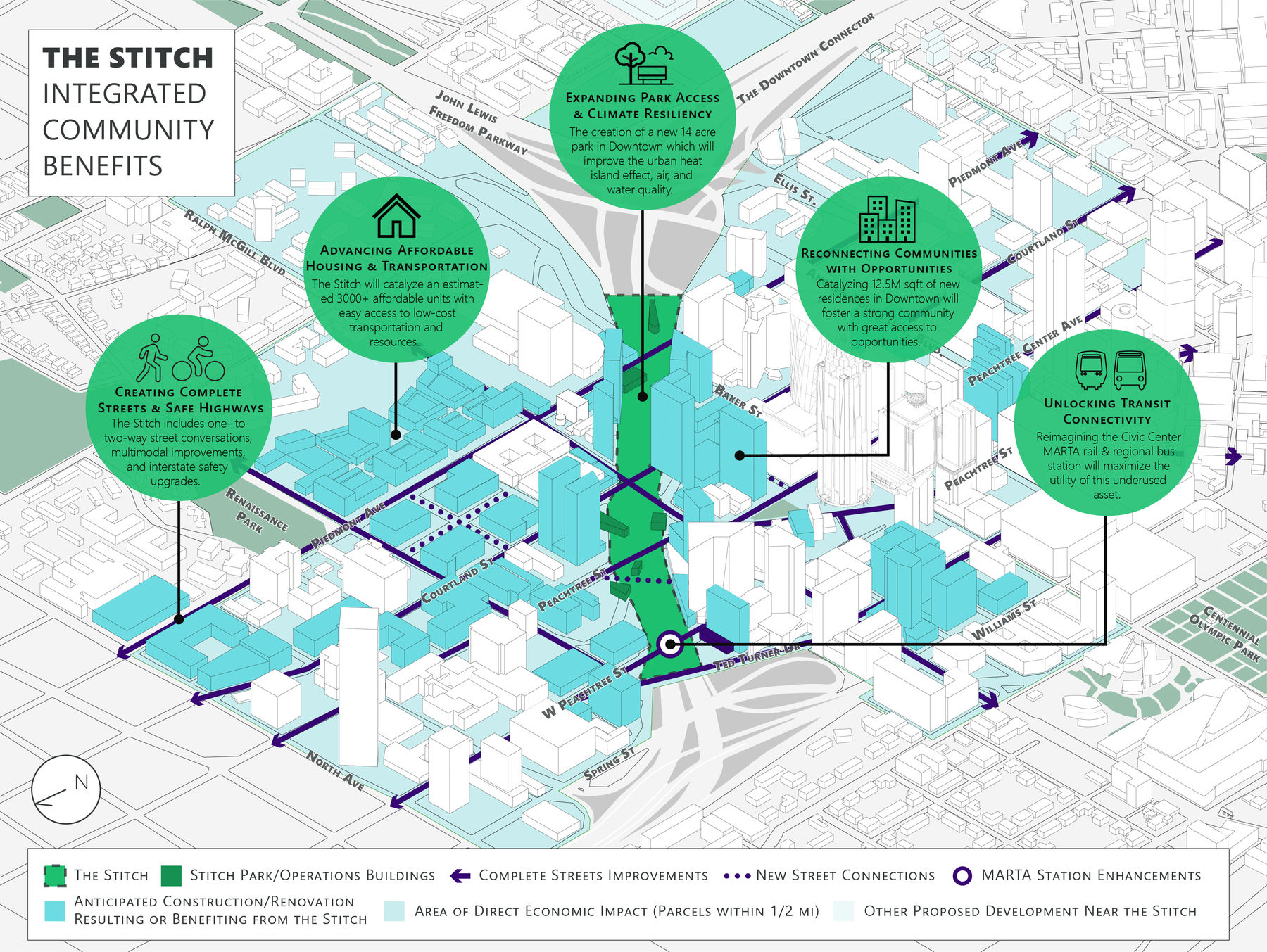The Impact
The Stitch will create a host of substantial benefits that will be felt throughout Downtown, the City of Atlanta, and the entire metro region. While ambitious, the Stitch is not unprecedented - it will join a number of other projects recently completed around the country to reclaim and reconnect urban areas that were fragmented by the construction of the Interstate highway system.
Summary of Benefits
The Stitch is a a visionary and collaborative project to help mend the damage from the the construction from the Downtown Connector, restore the vibrancy of Downtown, and address Atlanta’s challenge of affordable housing. The project aims to recreate a diverse and affordable Downtown community, connecting Atlantans to jobs, housing, transportation, parks, and resources.

Affordable Housing
The Stitch is estimated to generate 3,000 – 3,400 affordable housing units, 15%-17% of the Mayor’s citywide goal of 20,000 units. The Stitch Master Plan sets the goal that 30% of existing or new housing units in the area will be affordable for individuals and families making 80% or less of the area median income (AMI).
Proximity to transit and low-cost transportation options further reduce the cost of living for low-income residents. Approximately 20 acres in this area are already owned by affordable development-focused partners such as St. Luke’s Episcopal Church, Atlanta Housing (Civic Center Site), and Atlanta First United Methodist Church. With the right mix of supporting policies, funding, and partnerships, this number could be potentially be even higher.
Parks & Greenspace
The Stitch will create up to 17 acres of new parks in Downtown.
Today, Downtown only has 7 acres of parkland per 1,000 residents, a metric below Project Greenspace’s goal of 10 acres of parkland per 1,000 residents. The construction of the Stitch will significantly increase Downtown’s total green space through the introduction of a 14-acre park with thoughtfully designed and programmed active and passive spaces. The green space is expected to improve mental and physical health outcomes, particularly for marginalized and underserved populations.
Opened in 2012, Klyde Warren Park in Dallas, TX is 5-acre deck park over an eight-lane freeway. The project cost was $110M and the surrounding area has seen over $300M in value creation as a result. Its success has catalyzed a 2-acre expansion of the park, currently in development. (image source: klydewarrenpark.org)
Transportation
The Stitch will transform the way people move around Downtown Atlanta and connect to the region. This will support the City of Atlanta’s goal of reducing drive-alone trips from 54% to 35% by 2040.
The Stitch will include the re-design of all existing roads in the project footprint as more complete multimodal streets. This will slow speeds and improve safety for those traveling to and through Downtown in cars, on bikes, and on foot. Street design elements include converting one-way arterials to two-way streets, wider sidewalks buffered with street trees and green infrastructure, as well as dedicated, protected bike lanes. One historic street connection over I-75/85 (Alexander Street) will also be reestablished.
The Stitch will also rehabilitate and upgrade the MARTA Civic Center station with a new regional bus transfer center. Creating new transit-oriented development around the Civic Center station will give new residents direct access to low-cost transportation connecting to the entire region.
Finally, the Stitch will benefit traffic and safety on the Downtown Connector through the widening of shoulders and potential operational upgrades to the Williams/Spring Street interchange, Peachtree/Pine Street exit ramp, and Courtland Street exit ramps. A major benefit of the Stitch infrastructure to the mainline interstate is that it shifts the preference away from using I-75/85 for short local trips.
Sustainability and the Environment
The Stitch will Improve the sustainability of Downtown Atlanta by locally addressing flooding and mitigating noise and air quality impacts, while broadly lowering emissions, increasing pedestrian and bicycle use, and incorporating innovative climate change mitigation strategies.
The Stitch will reintroduce permeable surfaces to Downtown, and the 14-acre park will capture and filter stormwater runoff falling on site. The park is estimated to potentially capture, filter, and slow the peak runoff rate for 19M gallons of rainfall a year. A portion of this stormwater will also be stored in cisterns and reused for irrigation and other greywater uses in the park. Preliminary feasibility work suggests that the Stitch can reduce the peak stormwater flow rate between 11% and 33%.
Through the project's transportation improvements, the Stitch will reduce emissions through the mode shift away from single occupancy vehicles, as well as help reduce overall local trip generation. Furthermore, the planned off-street bus facility will include electric-bus charging infrastructure to support electric busses.
Finally, the Stitch will reintroduce green space and needed mid-story and overstory tree canopy in Downtown, reducing the urban heat island effect. This will help reduce cooling-related energy costs and make walking in Downtown more comfortable and accessible in the summer.
The trees and vegetation in Klyde Warren Park in Dallas were found to capture 18,500 lbs of carbon dioxide and reduce stormwater drainage by 64,214 gallons each year. The Stitch is expected to have similarly significant impacts, especially due to its size—14 acres—compared to Klyde Warren’s 5.2 acres. (image source: klydewarrenpark.org)
Economic Development
The Stitch will help reverse the persistent value gap in Downtown Atlanta. It is projected to spur $2-3 Billion in private investment generating $21-$58 million in new annual property tax revenue.
It is estimated to catalyze 14M sqft of new development. Nearly 90% of this new development is expected to be residential development with a goal of 20% or more affordable units for individuals and families making 80% or less of the area median income (AMI).
The Stitch will create an estimated 800 construction jobs, generate an estimated 12,230 permanent jobs to be housed in the newly-constructed residential, office and hotel developments, and develop a pathway to more jobs by physically closing the gap with Midtown.